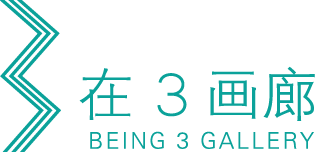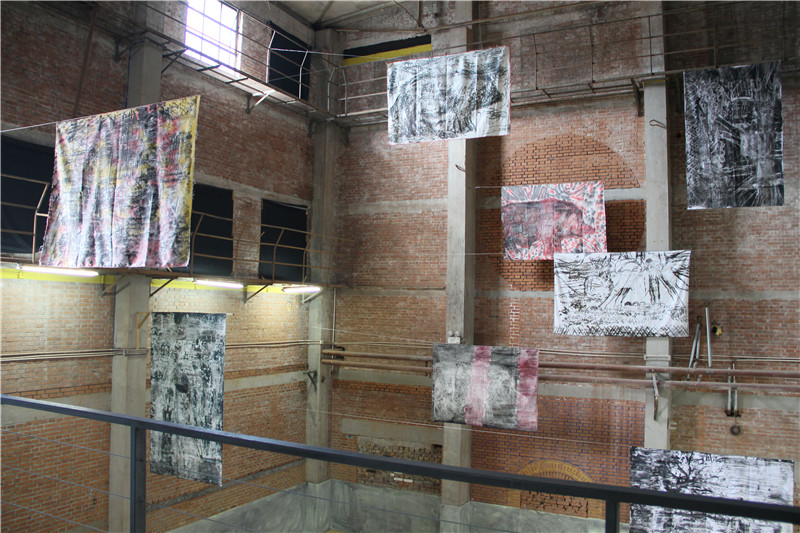
从未失效的精神叙事 ——于艾君“摸黑” A Mental Narrative that Never Lost its Potency — “Grope in the Dark” by You Aijun


2017年8月19日下午,艺术家于艾君个展“摸黑”在北京在3画廊拉开帷幕。与常见的绘画装饰白墙上的陈列方式不同,于艾君的绘画悬挂式入侵这所有着时间原迹的“教堂”高空,意味艺术对于时空的驾驭特权。
于艾君的作品,给予由于教条主义而不断变异的关于绘画的讨论归于本质。他不固定画面,使得绘画从西方架上艺术的归类上解放出来;他不断的通过绘画作自我的表达,情感的、眼见的、想象的、陌生的、思考的……并不取悦什么,让绘画摆脱实用主义的僵化要求和风格主义的庸俗格式;更重要的是,绘画,作为一种被艺术家选择的表达方式,并不存在“绘画已经死亡”这种字面理解的尴尬境遇。丹托宣布“绘画死亡”了,其实是指除了架上绘画,艺术家的表达方式大大拓展了的宣告!
仔细的欣赏于艾君的作品,会发现那些繁密复杂、不太清楚的线条下面藏着一个多变丰富、包罗万象的世界。他并不只描绘事物的肌肤,紊乱交错都在其上,潜滋暗长的是入微的观察与隐隐的骚动。说它们晦涩难解并不公允!这些作品不说教,也不昭示哲理,却充满人情味道和表现力:有些就像残留在石块上的公牛头像那样跃然布上,如《箭猪》;有些如同招魂帛画画着楚人一样,画面有隐约的当代人像,如《无缘无故的》;有些颜色和刮痕,就让情绪倾泻而出,《悲怆棚户区》嘈杂声和内心隐秘之伤四面八方涌过来;有些描绘了稀奇古怪的树丫或者一个村庄的标语,如《这是一个可怕的地方,然后我们……》、《张沙布新村欢迎你》……作品的名称都好像生活中写下的一些诗句和喟叹!这给出了作品就是艺术家人生存在过程中无处不在的精神痕迹的证明。在生命蓬勃的表达欲望面前,美学教条和精神教条都不攻自破。
展厅入口是一联排作品:《霍元艾小甲鱼之奇缘》。 这些作品根据80年代电影版连环画《霍元甲》剧照,虚构成一个新的故事。这件作品极具有私密情感和反思深意。70年代出生的艺术家,是在这些“小人书”的亲密陪伴下成长的,它们不仅丰富孩子的精神生活,也塑造极具民族主义色彩的“英雄”偶像供孩子膜拜……在经历了一系列的岁月涤荡以后,艺术家重新来晒晾儿时的精神食粮,抖落出一连串模糊印记。显然,他不再沿用英雄化这个传统程序,而是建构了复杂而微妙的“人性”故事。
另外的一件同样有关艺术家私人情感的作品《外婆的树丛》,带着对亲人纪念的仪式感单独的陈列在一个空间。艺术家在作品中使用了外婆的肖像,不过他只保留了外轮廓的剪影,那些树丛也好似树叶化石的样子,平面、凝固,透露出微动的形态、完整的结构和细致的脉络。《外婆的树丛》封存着珍贵的生命遗迹,它好似要说点什么亘古的事情,但显然漫长遥远,不可名状。
艺术家于艾君说,这个展览讨论绘画在尴尬层面的、别的可能性。在图像信息泛滥的时代,在观念与批判思潮至上的语境,在满目所见风格主义绘画的消费背景与极为实际的装饰的审美风尚之中,甚至在艺术史一环扣一环的牢牢的链条里,谁又能否认“绘画死亡”的事实呢?当今的绘画多少变成了一种附属的、服从的样式。在与摄影的夺权之间,在理论与学派的争论之间、在商店的橱窗和博物馆的隔板上,去寻找绘画的价值多少是有些荒谬的。要知道,从远古时候的那块石壁上的公牛头像开始,绘画在生命的真实和表达的本能之中就宣告了它的永生!
于艾君“摸黑”,以一种从未失效的、基于个体话语的精神叙事,突破了被技术与学问种种物料的层层包裹,探到了精神生活的深深来处……
文嘉琳
2017.8.19
In the after of August 19th, 2017, artist Yu Aijun’s solo exhibition “Grope in the Dark” was unveiled at the Being 3 Gallery in Beijing. Usually, paintings are displayed on white walls, but Yu Aijun’s paintings are hung from the Church, invading this space that readily displays the passage of time, denoting the privilege art holds over time and space.
Yu Aijun’s pieces take the ever-changing discussions about paintings back to its essence. He doesn’t fix down painting, thereby liberating paintings from the Western tradition of easel art; he continues to express, through his paintings, himself, his emotions, what he sees, thinks, the strange, the mind… he does not seek to please anyone, and releases paintings from utilitarianism and stylism; more importantly, art, as an expression of the artist, never meets the awkward situation of reading the words “paintings are dead” literally. When Danto announced that “paintings are dead”, he really means that paintings are now expanding beyond the easel, and the artist’s freedom has been expanded!
Examining Yu Aijun’s works, one finds that those intricate, unclear lines hide a rich world underneath. He is not just describing the skin of skins, but in the chaos, he is depicting detailed examinations and undercurrents. Saying that they are difficult is not fair! These pieces are not didactic, and do not philosophize, but are filled with humanity and expression: they are as animated as bulls in cave paintings, as in “Shooting Pigs”; or they act like a seance, depicting modern people in an ambiguous way, such as in “For No Reason”; In some pieces, the colors and scratches pour out like emotions, in “The Tragedy of Lean-To Houses”, noise and secrets pour in from all sides; Some depict weird trees and a slogan of a village, such as in “This Is a Scary Place, and then We…”, “Zhangshabu New Village Welcomes You”… the titles of the pieces are like lines of poetry and exclamation! These pieces are proofs of the artist’s life of the mind. In the face of such animated expressions of living, the formalities of aesthetics cave and break.
At the entrance of the exhibition are a series of painting: “The Accidents of HuoYuanAi XiaoJiaYu”. These pieces are based on stills from an animated series in the 80’s, and constructs a new story. This piece has both private emotions and reflective meaning. Artists born in the 70’s grew up reading these books, and they not only enriched the children’s mental lives, but also provided a “hero” of the local culture for the kids to idolize… after the passage of time, the artist suns his childhood mental food, and shakes out a bunch of fuzzy icons. Obviously, he is no longer making a hero out of this tradition, but rather, giving it some “humanity” in the new story.
Another piece that has to do with the artist’s private emotions is the piece “Grandma’s Forest”. It is displayed in a separate area, with a ceremonial feeling of remembering a loved one. The artist uses his grandma’s portrait, but only the outline. The trees looks more like fossilized leaves — flat, solid, yet displaying minute movement, complete structure, and intricate networks. “Grandma’s Forest” seals the precious tracks of life, as if it is trying to tell some ancient story that has happened a long time ago, and is no longer clear.
Artist Yu Aijun says, this exhibition discusses the other possibilities of painting at its awkward stage. In this age of overflowing visual information, where value and criticism are put at the forefront, in the consumerist age of paintings that display obvious styles and act as practical decorations, even in the links of the chain of art history, who can deny the truth of “paintings are dead”? Nowadays, paintings have become submissive. Between fighting with photography, between theory and academia, in the display windows of stores and on the walls of museums, trying to decide on the value of paintings is absurd. For, from the time of the bull being painted onto the stone wall, the eternity of painting as the instinct of life’s truth and expression has been declared!
Yu Aijun’s “Grope in the Dark” has reached the deeps of the life of the mind, with a mental narrative that has never lost its potency, and breaking through the covers of technology and knowledge.